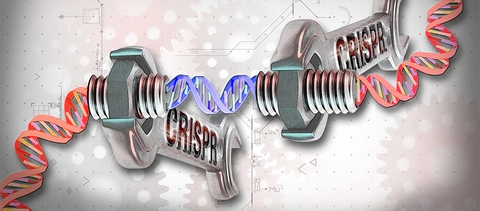
By Dr. Kelly O'Connell.
By now many people have heard of CRISPR-Cas 9 technology. CRISPR, or Clustered Regularly Interspaced Short Palindromic Repeats, along with Cas-9 (CRISPR-associated system 9), is a method used to target and edit DNA at precise locations in living cells. This has broad implications in treating human disease, specifically in the field of oncology.
CRISPRs were initially discovered in archaea and bacterial defense systems as way of recognizing, modifying and eventually storing recognition sequences from invading pathogens to form a bacterial adaptive immunity. CRISPRs contain short repeating sequences, separated by “spacer” sequences, which are genetic remnants of previous invaders. These spacer sequences are transcribed into RNA (sgRNA) which guides the system to the matching DNA sequence. Once it finds the DNA sequence, the Cas9 enzyme cleaves DNA at that precise location effectively turning off the target gene1. Cas9 can also be modified to activate expression as well.
In mammalian cells, a vector comprising the RNA sequences needed to guide Cas9 is transfected into the cell and delivered to the nucleus. Once in the nucleus, the Cas9 gene encoded by the vector is transcribed and translated before causing a double-strand break in the DNA target. When targeted to specific coding regions of genes, Cas9 is capable of causing various types of mutations, including a frame shift, resulting in a loss of function.
Cancer cells contain genetic abnormalities in chromosome structure that result in inappropriate expression of tumor-promoting genes. Dr. Zhang, the founder of CRISPR’s cancer fighting utility from MIT, used this technology to create a genome-wide screening of the loss-of-function of over 18,000 genes. He essentially explored how knocking out individual genes affects viability and drug resistance in hopes of finding new therapeutic targets2.
In addition to the utility of the CRISPR-Cas9 system as a large-scale screening tool, it can also be used to rapidly develop disease models. Classically, the development of a tumor-bearing animal models occurred through genetic manipulations in the germline with successive breeding protocols to produce a stable transgenic line. Though somatic mutations are more challenging, Platt et al bypassed these challenges by creating a Cre-dependent Cas9-knockin mouse3. By delivering a tissue-specific package of the remaining CRISPR-Cas9 ingredients along with an RNA guide, they were able to develop multigenic cancer mutations and create macroscopic tumors.
Undoubtedly, the CRISPR-Cas9 technology has rapidly expanded the field of biomedical research. The ability to efficiently screen for new therapeutic targets and create somatic mutations to develop tumor models has redefined cancer research. Indeed, the sheer number of applications in vivo and in vitro of this technology are staggering4. The exponential increase in publications on this topic in just the past 4 years hints that this is just the beginning.
References:
- https://www.broadinstitute.org/what-broad/areas-focus/project-spotlight/questions-and-answers-about-crispr
- Shalem O, Sanjana NE, Hartenian E, Shi X, Scott DA, Mikkelson T, Heckl D, Ebert BL, Root DE, Doench JG, Zhang F. Genome-Scale CRISPR-Cas9 Knockout Screening in Human Cells. Science 2014 Jan 3;343 (6116):84-87.
- Platt RJ, Chen S, Zhou Y, Yim MJ, Swiech L, Kempton HR, Dahlman JE, Parnas O, Eisenhaure TM, Jovanovic M, Graham DB, Jhunjhunwala S, Heidenreich M, Xavier RJ, Langer R, Anderson DG, Hacohen N, Regev A, Feng G, Sharp PA, Zhang F. CRISPR-Cas9 Knockin Mice for Genome Editing and Cancer Modeling. Cell 2014 Oct 9:2(159):440-455.
- Chira S, Gulei D, Hajitou A, Zimta AA, Cordelier P, Berindan-Neagoe I. CRISPR/Cas9: Transcending the Reality of Genome Editing. Mol Ther Nucleic Acids. 2017 Jun 16;7:211-222.